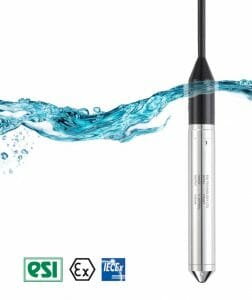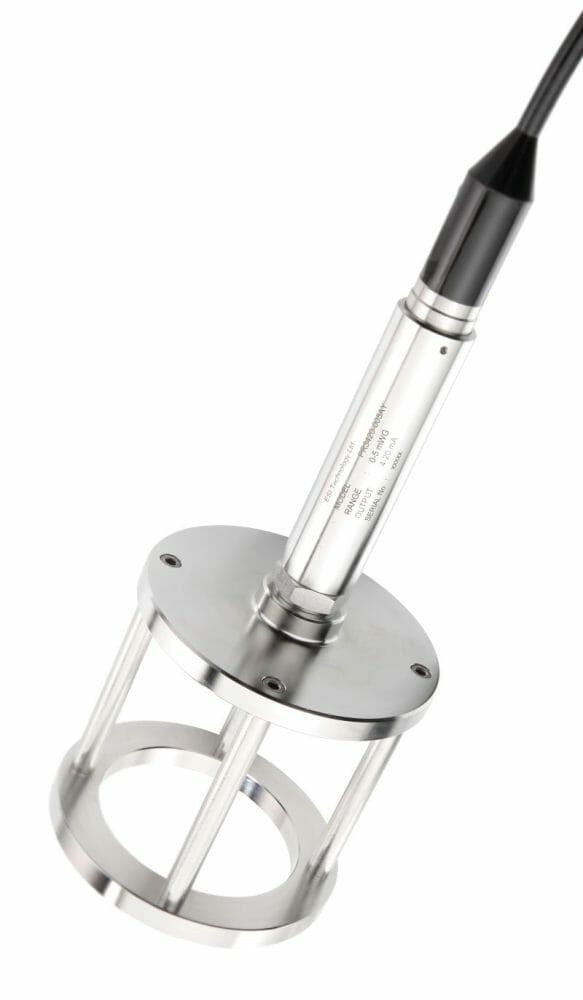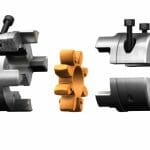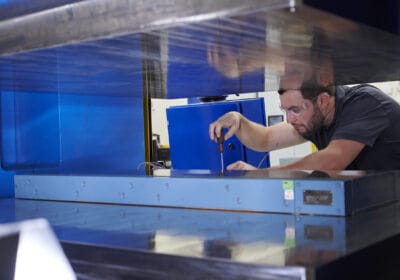What is Hydrostatic pressure and how does ESI’s Hydrostatic level measurement technology work?
What is Hydrostatic pressure?
Hydrostatic pressure is commonly described “The pressure equivalent to that exerted on a surface by a column of water of a given height due to the force of gravity”. A liquid column above the pressure sensor creates hydrostatic pressure, which is a direct indicator for the liquid level. Generally, the standard unit of measurement is calibrated in metres of water gauge (mWG). This may sometimes be referred to as metres of water column (mWC), or metres of H2O (mH2O). Other countries may use different units of measurement, such as inches of water column (“WC).
How does an ESI Hydrostatic level transmitter work?
The measuring cell of the pressure sensor detects small changes in hydrostatic pressure, which increases or decreases according to the filling level.
The ESI sensor is powered by a vented cable and is submerged into the liquid to be monitored. The sensor converts the acting pressure into an electrical signal. Most users will typically require a 4-20mA output, enabling signals to be transmitted over long distances. Cable can be supplied in continuous lengths of up to 500m.
In most applications the liquid is subjected to atmospheric pressure. To provide accurate electrical measurement it is important that readings are compensated to allow for any changes in atmospheric (barometric) pressure. This compensation is achieved by using a vented cable which the ESI sensor to “breathe” to the atmosphere. This is done through a small nylon tube that runs through the cable which ensures that the output reading is relative to atmosphere. This is particularly important for the measurement of low levels of liquid, where changes in barometric pressure can significantly affect the true reading of level. For example, at high altitude where low atmospheric pressure is present.
 In order to calibrate the device, a factor is used to convert bar to mWG. This ensures the accuracy of the reading. The standard unit of measurement is calibrated in meters of water gauge (mWG). ESI can calibrate and label sensors in units of measure determined by particular applications. For example in a diesel tank application the sensor can be calibrated in meters of diesel.
In order to calibrate the device, a factor is used to convert bar to mWG. This ensures the accuracy of the reading. The standard unit of measurement is calibrated in meters of water gauge (mWG). ESI can calibrate and label sensors in units of measure determined by particular applications. For example in a diesel tank application the sensor can be calibrated in meters of diesel.
In most applications the sensor can be connected to a system via a simple IP67 rated terminal box, with glands to prevent water ingress. In certain applications, where over a long period of time moisture from high humidity may enter the vented tube it is advisable to use a desiccant filter. The desiccant absorbs moist air, preventing any moisture travelling to the sensing element and causing a short circuit.
What types of applications are they useful for?
Hydrostatic level sensors can be permanently immersed in boreholes for measuring the depth of the water table for example. The water table is the underground depth at which the ground is totally saturated. Deep boreholes with an average diameter of 25mm are drilled and left to fill to the level of the water table. A small diameter submersible pressure sensor is lowered down the borehole to accurately measure the level. In this type of application the control system would normally incorporate a barometric sensor, which is used to compensate for changes in atmospheric pressure.
ESI sensors are available with ATEX and IECEx certification and can therefore be used in similar circumstances where there is a risk of explosion. For example, monitoring the water levels in coal seam gas wells.
ESI Hydrostatic Level sensors are also well suited to measuring the levels of fluids in storage tanks. The sensor is lowered to the bottom of the tank via an access hole in its top. The sensor cable is then connected back to a monitor, data logger, or PLC. Other areas where Hydrostatic level sensors can be effectively used are in the measuring of the level of water in rivers and reservoirs.
Hydrostatic level sensors are typically manufactured from 316l stainless steel. This makes them suitable for immersion in most media. Other materials such as plastic, titanium and hastalloy C may be used to ensure compatibility with whatever medium is being measured, where stainless steel is not suitable. A polyurethane jacketed vented cable ensures excellent media compatibility, with oil for example. Other materials, such as nylon and PTFE may be used if the medium requires it.
The advantages of using an ESI Hydrostatic level measurement sensor are that the vessel does not need to be disturbed or adapted to fit a level sensor. There is no need to install tank wells or sight glasses, etc. It allows levels to be measured under difficult conditions, such as down a deep shaft. The probe is easily extracted for cleaning and maintenance purposes. It is a highly reliable and robust solution.
To find out more about our range of depth and level pressure transmitters visit www.esi-
tec.com or contact us: +44(0)1978 262255/ [email protected]








